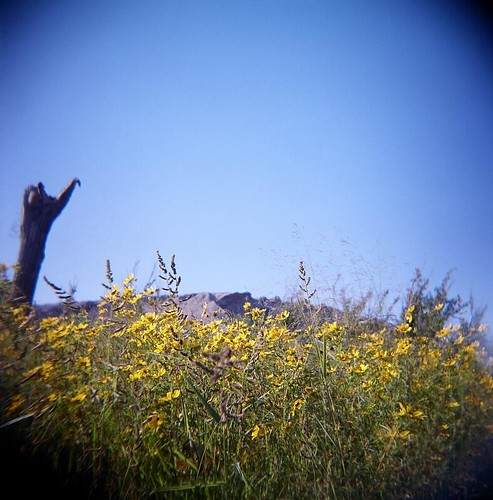
[photo: Wildflowers bloom this summer in front of a mountain of toxic mining waste in Picher, which is in the northeast corner of Oklahoma. The government is currently paying residents to relocate from the area.]
Welcome to Oklahoma's newest source for environmental news. I'm John Sutter, the author of this blog and the former environment reporter at The Oklahoman. (You may have seen my blog with the paper: Going Green.)
I'm starting this site because I believe that Oklahomans care about environmental news and issues, and they deserve to have a place to find stories on the topic. I am not an advocate or an environmentalist, but I do believe that decisions by government and business affect the environment. I'm here to make sure they're at least known and considered.
I also hope to use this site as a way to continue my interest in this state's diverse and endlessly interesting ecology. Even if you've lived here all of your life, you may not know that Oklahoma is actually home to more distinct ecological zones than any state but Alaska. Because of weird weather patters we see here -- with lots of wet air sweeping in from the Gulf of Mexico and lots of hot, dry air shooting north from Mexican deserts -- Oklahoma has swamps with alligators in the southeast and sees dust storms on the high plains in the northwest and in the Panhandle. It's a diverse and wild place. One worth exploring.
Many of the state's environmental issues are pressing, yet they're under-reported. The state Attorney General is suing poultry companies over their alleged pollution of the Illinois River in northeast Oklahoma. Tar Creek, a former lead and zinc mining site, has been listed as one of the most severe toxic waste sites in the nation. Thirty years after the U.S. Environmental Protection Agency started work there, it's still not cleaned up or safe, and now the government is paying people to move out because of safety and environmental hazards.
In northwest Oklahoma, the lesser prairie chicken -- a hilarious bird with a certain YouTube celebrity -- could be headed towards extinction because of wind farm expansion. And, really for the first time, alternative fuels like wind and prairie-grass biofuels are being talked about as viable alternatives to Oklahoma's oil-and-gas-driven economy.
This is an exciting and important time for environmental issues in the state. I hope you will join the conversation here and elsewhere. Check out the blogroll for ideas about other sites to visit, and let me know what you think of this one by commenting on stories, or sending me an e-mail at john.d.sutter [at] gmail.com. If you have a question you'd like me to answer or a topic you'd like me to write about, just let me know.
--John




3 comments:
Alleged pollution investigation:The undersigned Independent Ship and Marine Surveyors carried out an inspection onboard the detained vessel at the port, in order to investigate the reportedly suspicious alleged oil pollution caused by a container vessel and to intervene with the authorities in order to release the vessel without any delays and to protect the interests of the underwriters.
For More Articles visit :-Articles by marine surveyors
Post a Comment